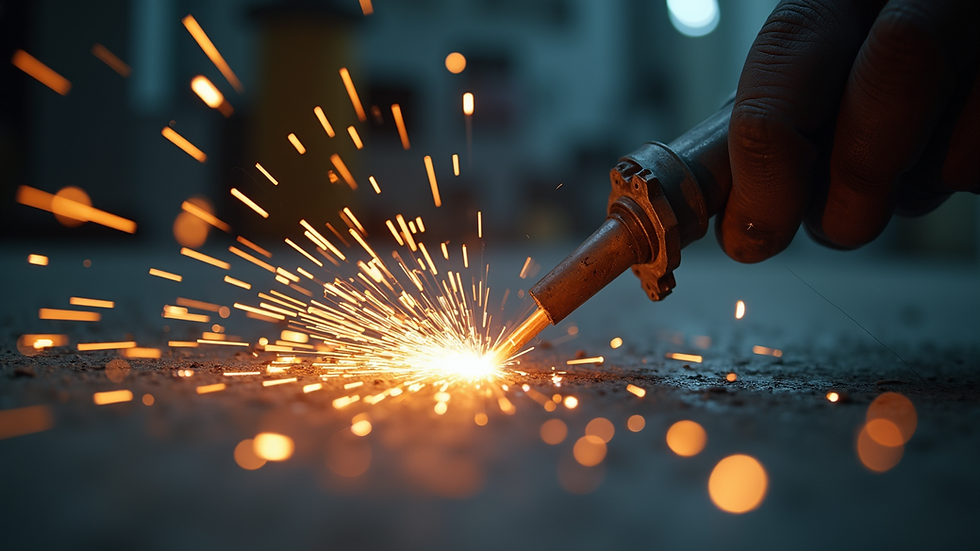Welding Basics for Beginners: Getting Started
- russ192
- Sep 18, 2025
- 3 min read
Welding is a valuable skill that opens up many opportunities in construction, manufacturing, and creative projects. For those just starting, understanding the fundamentals is essential to build confidence and ensure safety. This guide will walk you through the essential concepts and practical tips to get started with welding.
Understanding the Basics of Welding
Welding is the process of joining two pieces of metal by melting their edges and adding a filler material to form a strong bond. There are several types of welding, but the most common for beginners include:
MIG Welding (Metal Inert Gas): Uses a wire electrode and shielding gas to protect the weld.
TIG Welding (Tungsten Inert Gas): Uses a tungsten electrode and requires more skill but produces precise welds.
Stick Welding (Shielded Metal Arc Welding): Uses a consumable electrode coated in flux.
Each method has its advantages and is suited for different materials and projects. Beginners often start with MIG welding because it is easier to learn and faster for most applications.
Safety is paramount in welding. Always wear protective gear such as a welding helmet with the correct shade, gloves, flame-resistant clothing, and ensure proper ventilation to avoid inhaling fumes.

Introductory Welding Techniques to Master
Before diving into complex projects, mastering some basic techniques will help you create strong, clean welds. Here are some key skills to focus on:
Proper Setup
Ensure your welding machine is set to the correct amperage and wire feed speed for the material thickness. Incorrect settings can cause weak welds or burn-through.
Correct Electrode Angle
Hold the welding gun or electrode at a 10 to 15-degree angle from vertical. This helps the molten metal flow smoothly and prevents defects.
Steady Travel Speed
Move the welding torch at a consistent speed. Too fast can cause weak welds, while too slow can create excessive buildup and burn marks.
Maintaining a Clean Work Surface
Remove rust, paint, and dirt from the metal before welding. Clean surfaces ensure better fusion and reduce contamination.
Practice Bead Welding
Start by welding simple beads on scrap metal. Focus on creating uniform, smooth beads without gaps or excessive spatter.
By practicing these techniques regularly, you will develop muscle memory and improve your weld quality.

What Should I Learn First in Welding?
When beginning your welding journey, it’s important to build a solid foundation. Here’s a recommended learning path:
Learn Welding Safety
Understand the hazards and how to protect yourself. This includes knowing how to use personal protective equipment (PPE) and handling equipment safely.
Understand Welding Equipment
Familiarise yourself with the welding machine, types of electrodes, shielding gases, and accessories.
Practice Basic Welds
Start with simple butt joints and lap joints on mild steel. Focus on controlling the arc and maintaining a steady hand.
Study Welding Symbols and Blueprints
Learn to read welding symbols and basic blueprints to understand project requirements.
Experiment with Different Positions
Welding flat, horizontal, vertical, and overhead positions require different techniques. Begin with flat and progress gradually.
Taking a structured approach will help you avoid frustration and build confidence as you progress.

Essential Tools and Equipment for Beginners
Starting with the right tools makes learning easier and safer. Here’s a list of essential equipment for beginners:
Welding Machine
A MIG welder is recommended for beginners due to ease of use.
Welding Helmet
Choose an auto-darkening helmet for convenience and eye protection.
Welding Gloves and Jacket
Protect your hands and body from heat and sparks.
Angle Grinder
Useful for cleaning metal surfaces and smoothing welds.
Clamps and Magnets
Hold metal pieces securely in place during welding.
Wire Brush and Chipping Hammer
Clean slag and spatter from welds.
Investing in quality gear will improve your welding experience and results.
Tips for Improving Your Welding Skills
Improvement comes with practice and attention to detail. Here are some actionable tips:
Watch Tutorials and Take Classes
Visual learning helps you understand techniques better.
Join Welding Forums and Communities
Share your work and get feedback from experienced welders.
Keep a Welding Journal
Record settings, materials, and results to track progress.
Experiment with Different Materials
Try welding steel, aluminium, and stainless steel to broaden your skills.
Focus on Consistency
Aim for uniform weld beads and clean joints.
By following these tips, you will steadily enhance your welding abilities.
Moving Forward with Welding
Welding is a skill that combines art and science. As you gain experience, you can take on more complex projects and explore advanced techniques like TIG welding or pipe welding. Remember, the key to success is patience, practice, and continuous learning.
For more detailed guides and resources on welding, check out this comprehensive welding basics for beginners resource.
Start your welding journey today and unlock the potential to create strong, lasting metalwork with confidence.






Comments